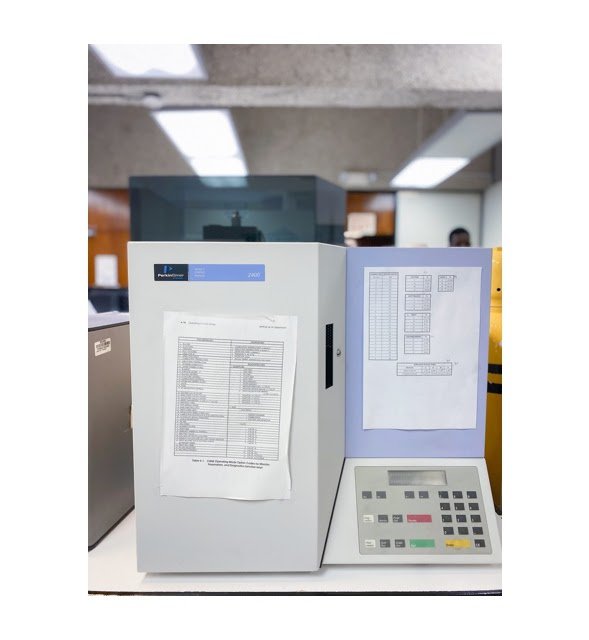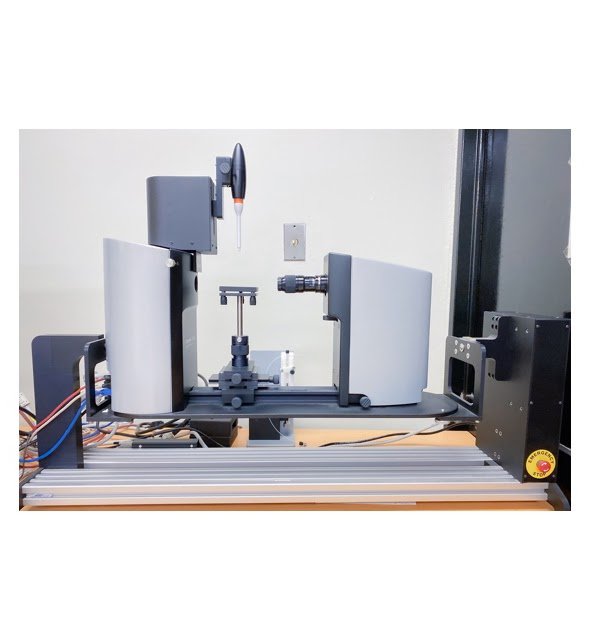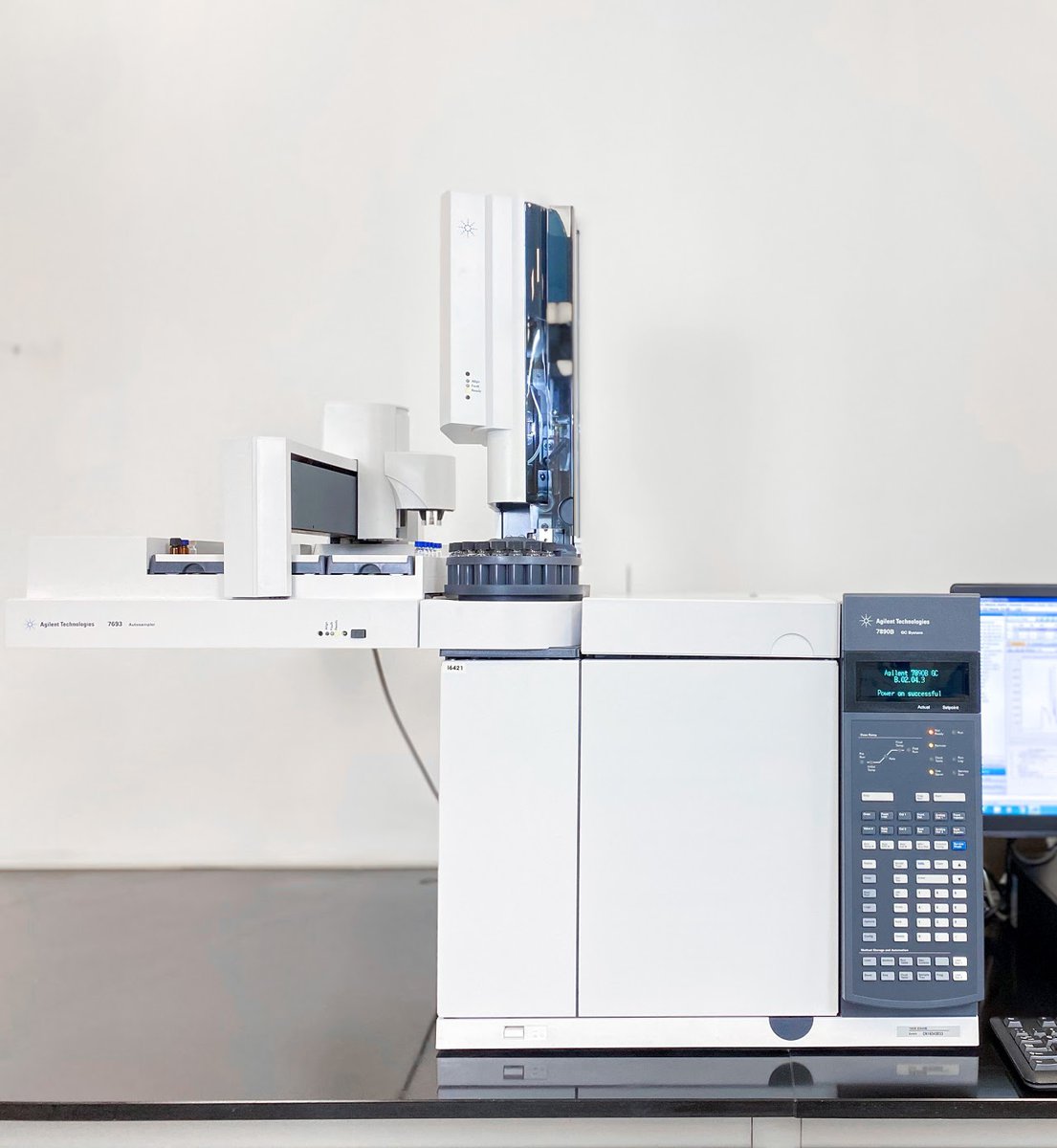Separation Laboratory
Description
Description
Description
| Instrument | KFUPM First | KFUPM Additional | Non-Profit First | Non-Profit Additional | Commercial First | Commercial Additional |
|---|---|---|---|---|---|---|
| Elemental Analyzer | 150 | 130 | 225 | 195 | 600 | 520 |
| Tension Meter | 180 | 160 | 260 | 230 | 720 | 640 |
| GCMS | 250 | 220 | 300 | 270 | 1000 | 880 |
| LCMS | 300 | 250 | 450 | 375 | 1200 | 1000 |
| GC-IR | 300 | 250 | 450 | 375 | 1200 | 1000 |
| GC | 300 | 250 | 450 | 375 | 1200 | 1000 |
| HPLC | 300 | 250 | 450 | 375 | 1200 | 1000 |
| Mass Spectroscopy | 300 | 250 | 450 | 375 | 1200 | 1000 |
Description
Description

Location:
Chemistry Department
Phone: 92318
Building #4, Room #239
Scientist In-Charge:
Name: Mr. Darwin Mapanao
Phone: 2318
E-mail: dmapanao@kfupm.edu.sa
Elemental Analyzer
Instrument description
The 2400 Series II CHNS Elemental Analyzer is capable of operating in two modes: CHNand CHNS, is fully automated, and includes a 60 position autosampler. In addition to theinstrument's "tried and true" design features, the 2400 Series II CHNS System includesour intuitive, easy-to-use, EA Data Manager Software. The EA Data Manager softwareadds powerful capabilities that assist in streamlining your data collection and analyses.
Main Features:
Determine weight percent carbon, hydrogen, nitrogen, or sulfur in a variety of sampletypes
Perform advanced calculations and/or recalculate results Operate in 2 modes: CHN and CHNS

Location:
Chemistry department
Phone: 92318
Building #4, Room #239
Scientist In-Charge:
Name: Mr. Darwin Mapanao
Phone: 2318
E-mail: dmapanao@kfupm.edu.sa
Tension Meter
Theta harnesses the power of full automation to deliver unparalleled performance and ease of use for the most demanding research andindustrial applications. It is able to perform the complete range of measurements, namely static contact angle (sessile drop method, captivebubble method, meniscus method), dynamic contact angle (tilted drop method and sessile drop method), surface free energy, surface/interfacial tension (pendant drop method, reverse pendant drop method), 3D surface roughness (Fringe projection phase shifting method bythe 3D Topography module) and interfacial rheology (dilational rheology by the pulsating drop method). The drop volume is also measured.
Main Features:
Description

Location:
Chemistry Department
Phone: 92318
Building #4, Room #239
Scientist In-Charge:
Name: Mr. Darwin Mapanao
Phone: 2318
E-mail: dmapanao@kfupm.edu.sa
GCMS-QP2010 Ultra Gas Chromatography Mass Spectrometer
Capable of fast data measurement with sensitivity five times higher than previous models, the GCMS-QP2010 Ultra offers improved applicability for comprehensive two-dimensional GC and ultra-high separation. Shimadzu used new, patented mass spectrometry technology called Advanced Scanning Speed Protocol (ASSP™), a firmware protocol that optimizes the ion transmission hardware parameters with a highly efficient data collection algorithm, to increase data acquisition speed up to 20,000 u/sec and 100 Hz.
Main Features:
- help increase throughput, the GCMS-QP2010 Ultra features high-speed oven cooling for shorter analysis cycles. Using a double jet coolingsystem, the GC cools from 350 to 50 degrees Celsius in less than three minutes. The combination of a high-speed GC method and a high-speed cooling oven can reduce the analysis cycle by up to 50 percent.
- further increase lab efficiency, the GCMS-QP2010 Ultra can accept two narrow-bore capillary columns into the MS simultaneously. Its twin-line MS system allows users to switch applications without physically modifying the column installation. Users simply decide which columns are required for analysis and choose the associated injection port.

Location:
Chemistry department
Phone: 92318
Building #4, Room #239
Scientist In-Charge:
Name: Mr. Darwin Mapanao
Phone: 2318
E-mail: dmapanao@kfupm.edu.sa
Mass Spectroscopy
The LCQ Fleet is a 3D quadrupole ion trap mass spectrometer that includes a syringe pump, a divert/inject valve, and an Ion Max-S™ API source
Main Features:
The instrument consists of an API source, ion optics, a mass analyzer, and an ion detection system. The ionoptics, mass analyzer, ion detection system, and part of the API source are enclosed in a vacuum manifold.

Location:
Chemistry department
Phone: 92318
Building #4, Room #239
Scientist In-Charge:
Name: Mr. Darwin Mapanao
Phone: 2318
E-mail: dmapanao@kfupm.edu.sa
LCMS-8050 Triple Quadruple Liquid Chromatograph Mass Spectrometer (LC-MS/MS)
Enhancements in chromatography and sub-2 micron columns have caused narrower peak widths,increasing resolution. In addition to high-resolution columns, analysts are demanding shorterchromatographic run times while adding more analytes to a single method. With these two factors atplay, it is clear that the LCMS-8050 ultra fast mass spectrometer is needed in order to accurately andreliably detect each compound in a sample.
Main Features:
- UF Technology Meets Ufsensitivity
When one combines ultrafast scan speeds with ultrafast polarity switching and ultrafast MRM acquisition, it is no wonder why aShimadzu mass spectrometer can reproducibly obtain both quantitative and qualitative data. These three unique pieces of hardwareform our UFtechnology, which allows us to be the leader in quantitative mass spectrometry.
- Ufscanning
The LCMS-8050 delivers the world’s fastest scan speeds of up to 30,000 u/second with a 0.1 Dalton step size without the loss of massaccuracy. Data acquisition occurs so rapidly that triggered MS/MS scans and MRM quantitation can be performed in a single acquisitionmethod.
- Heated ESI Probe
A new state-of-the-art heated ESI probe improves desolvation efficiency to achieve trace detection and quantitation. This probecombines a high-temperature gas with the nebulizer spray, assisting in the desolvation of large droplets and facilitating ionization.

Location:
Chemistry department
Phone: 92318
Building #4, Room #239
Scientist In-Charge:
Name: Mr. Darwin Mapanao
Phone: 2318
E-mail: dmapanao@kfupm.edu.sa
GC-IR
The GC-IR Interface is optimized for analyzing small elution volumes found in high-resolution capillarycolumns. The system achieves excellent sensitivity, typically in the low nanogram range for volatilespecies. The combination of the GC-IR Interface with Thermo Scientific Nicolet FT-IR spectrometersprovide an effective tool for analyzing multi-component organic samples, including solvents, reactants,pharmaceuticals, petrochemicals, and environmental samples.
Main Features:
- Capillary column can be inserted directly into the light pipe, eliminating component degradation and peak broadening in the transfer line
- Gold-coated light pipe with long path length and small inside diameter maximizes the infrared response for low
nanogram sensitivity
- Patented MCT-A detector contributes to the system's unmatched sensitivity and dependability
- Pinned-inplace Smart detectors can be interchanged with the bench detector without alignment
- Smart detectors, with a plug-and-play feature, provide instant recognition of the detector and its location
- Smart detectors feature a patented mechanism to prevent the formation of ice on the detector element and provide an 18-hour liquid hold-time

Location:
Chemistry department
Phone: 4438
Building #4, Room #239
Scientist In-Charge:
Name: Mr. Darwin Mapanao
Phone: 2318
E-mail: dmapanao@kfupm.edu.sa
GC-MS
Agilent Gas Chromatography (GC-MS) is a user-friendly instrument that used to separate organiccompounds from volatile to low molecular weight analytes. It has a high degree of analysis automationand meets the user requirements with respect to its sensitivity and reproducibility. ChemStation softwareprovides the instrument to control the system whether online or offline mode. Application varies such asenvironmental monitoring, eg. disinfection by-products and industrial application such as oil and gas.
Main Features:
A regulated and purified carrier gas source, with traps for water, hydrocarbons and oxygen is recommended, whichmoves the sample through the GC.
• A manual or automatic injection with different sampling techniques like liquid, headspace and solid phasemicroextraction (SPME).
• An inlet, which also acts as a vaporizer for liquid samples. The most common inlets are injection ports and samplingvalves.
• A column, in which the time separation occurs and most separations are highly temperature-dependent, so thecolumn is placed in a well-controlled oven. Polar and non-polar columns are used on case to case basis.
• A detector, which responds to the components as they occur by changing its electrical output. Mass Spectrometer(MS) with triple axis detector

Location:
Chemistry department
Phone: 92318
Building #4, Room #226 and #239
Scientist In-Charge:
Name: Mr. Darwin Mapanao
Phone: 2318
E-mail: dmapanao@kfupm.edu.sa
High Performance Liquid Chromatography (HPLC)
High Performance Liquid Chromatography (HPLC) is a highly versatile technique that separates components of a liquid mixture based on their different interactions with a stationary phase. Samples with high molecular weight, even complex compounds, are important to be detected in HPLC. A system that contains five different modules and works as one namely, pump, sampler, column compartment (with oven) , detector and computer. The column, as the heart of the instrument, makes the instrument selective and sensitive to hundreds or thousands of analyte in liquid solution. It has a wide range of application areas such as pharmaceutical, food, biotechnology, environmental, agriculture, etc.
Main Features:
Pump , binary or quaternary, is operated with high pressure and maintains a constant flow of mobile phase through the HPLC system.
Column, analytical or preparative, is responsible for adequate separation of analytes and the efficiency correlates with the column inner diameter, length, type and particle size of the column packing material, as the stationary phase.
Detector is capable of determining the identity and concentration of eluting compounds in the mobile phase. Available detectors are Diode Array Detector (DAD), Fluorescence Detector, Conductivity Detector and Mass Spectrometer.

Location:
Chemistry department
Phone: 4438
Building #4, Room #239
Scientist In-Charge:
Name: Mr. Darwin Mapanao
Phone: 2318
E-mail: dmapanao@kfupm.edu.sa
Gas Chromatography (GC)
Agilent Gas Chromatography (GC) is a user-friendly instrument that used to separate organic compounds from volatile to low molecular weight analytes. It has a high degree of analysis automation and meets the user requirements with respect to its sensitivity and reproducibility. Chem Station software provides the instrument to control the system whether online or offline mode. Application varies such as environmental monitoring, eg. disinfection by-products and industrial application such as oil and gas.
Main Features:
A regulated and purified carrier gas source, with traps for water, hydrocarbons and oxygen is recommended, which moves the sample through the GC.
• A manual or automatic injection with different sampling techniques like liquid, headspace and solid phase micro extraction (SPME).
• An inlet, which also acts as a vaporizer for liquid samples. The most common inlets are injection ports and sampling valves.
• A column, in which the time separation occurs and most separations are highly temperature-dependent, so the column is placed in a well-controlled oven. Polar and non-polar columns are used on case to case basis.
• A detector, which responds to the components as they occur by changing its electrical output. Detectors used are following with different units:
a. Flame Ionization Detector (FID) - for liquid and gas samples
b. Thermal Conductivity Detector (TCD) - for liquid and gas samples
c. Sulfur Chemillumine scence Detector (SCD)
d. Pulse Discharge Helium Ionization Detector (PDHID)
• Data interpretation of some sort, which the chromatogram with analyte’s compositions were reported.